National Canvas
By Amra Ali | Art | Arts & Culture | Published 9 years ago
Art in Pakistan has come of age. 2015 showcased both the diversity and ever-expanding spectrum of Pakistani art, as well as its increasing presence in the international art circuit, with artists such as Simeen Farhat having shown at the Venice Biennale and experimentation in new media at Toronto’s Nuit Blanche by Faisal Anwar. Closer to home, Akram Dost showed a large body of work that speaks about the social injustices in his native Balochistan, Rabeya Jalil discusses her intuitive process and the child-inspired gestural imagery in her recent paintings shown in Islamabad and Karachi. Zarmeenah Bakhtiyar develops her semi-realistic and imaginary landscapes inspired by the changing light and natural elements, and Shazia Zuberi comes back to her studio pottery and clay works after a hiatus of some years, both artists showing in Karachi. In Lahore, Ali Azmat develops a body of work inspired by the pehalwan culture of Akkara, and links it to local visual iconography, and Rahim Baloch, a recent miniature graduate of the NCA, Lahore, holds his debut exhibition of large-scale works inspired by the Mughal ateliers. Newsline invited each of these artists to share one work, or some aspect of their work exhibited in 2015.
Rahim Baloch is a Lahore-based miniature painter.
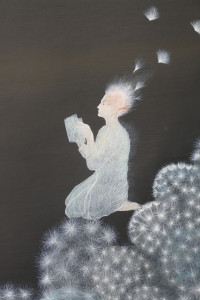 “I have seen great pain in my life, losing those I loved most very early in life. When I paint I find comfort. I use dandelion flowers in my paintings. In our Balochi language we call themkhabarak, meaning messenger. In my childhood I would talk to them of my feelings. I strongly believed that they sent my messages to my loved ones. So those, my childhood fantasies became everlasting, beautiful memories. This work is the only one with a figure. I use it to symbolise an angel, a light presence almost floating on balls of dandelions. It is with intense concentration that I am able to achieve the subtlest gradations of colour. My paintings are done painstakingly with one squirrel hair, and the process becomes almost meditative as I labour over the surface with fine feather-like lines. My vision necessitates the large scale; it is a challenge that changes the entire perception of space. This painting is from my body of work ‘Microcosm of Innocence,’ shown in Karachi in 2015. It is my most ambitious series. ”
“I have seen great pain in my life, losing those I loved most very early in life. When I paint I find comfort. I use dandelion flowers in my paintings. In our Balochi language we call themkhabarak, meaning messenger. In my childhood I would talk to them of my feelings. I strongly believed that they sent my messages to my loved ones. So those, my childhood fantasies became everlasting, beautiful memories. This work is the only one with a figure. I use it to symbolise an angel, a light presence almost floating on balls of dandelions. It is with intense concentration that I am able to achieve the subtlest gradations of colour. My paintings are done painstakingly with one squirrel hair, and the process becomes almost meditative as I labour over the surface with fine feather-like lines. My vision necessitates the large scale; it is a challenge that changes the entire perception of space. This painting is from my body of work ‘Microcosm of Innocence,’ shown in Karachi in 2015. It is my most ambitious series. ”
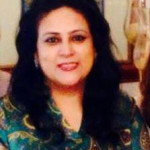 Zarminah Bakhtiar Khan is an emerging landscape painter fromKarachi.
Zarminah Bakhtiar Khan is an emerging landscape painter fromKarachi.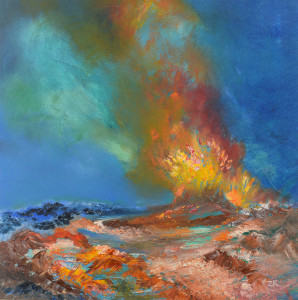
A lot of my paintings are of Pakistan and reflect the diversity of emotions the country evokes within me. From enduring patriotism, love and optimism to sudden darkness when tragedy strikes. This painting is different. It has its roots in a trip I took to Iceland. I was lucky enough to travel around and witness the diverse topographies of Iceland. I began to understand why it is often called a land of ‘fire and ice,’ with its striking mix of glacial rivers and rugged volcanoes. I watched the Aurora Borealis, and as the glowing mix of natural lights and colors danced through the sky, I was lost in the surreal beauty of this land. I found myself in a trance-like state, where worries of everyday, routine existence fell away, and the only certainty was a deep connection to the land itself, to the earth in its purest form. My painting turned into a blaze of colours: fiery, energetic — compelling you to stand and watch as beauty and destruction clash in an explosion by the winter sea. But fire evokes shades of hope, too. There’s always an odd sense of serenity in watching a glowing fire. Phoenixes rise from the ashes; there can be no creation without destruction. And when nature confronts you with a glowing, burning volcano — the viewer and nature are one. Working in clay is one of the most exciting processes — ask anybody involved in clay, they will give you a similar response. It involves experimentation and discovery; the more you work in clay, the more you realise there is so much else to learn and discover. It’s a process with a steep learning curve. Each stage of working with clay, building, firing and glazing involves its own self-contained creativity, allowing the artist to grow and deepen his/her own understanding of this ever-so-vibrant material. I, as an artist, am interested in the construction of sculptural work. I have in the past — and continue to — use a combination of hand-building and throwing techniques, complimented with the use of surface slips gently burnished into the ‘green’ form in order to maintain a smooth matte satin finish, reminiscent of weathering by water and air. With a focus on surface textures using traditional red clay, as they did a millennium ago in the Moenjodaro and Harappa civilisations, my latest series conceptually evokes the timeless process of erosion. Even though my earlier work was heavily scoured with texture and figurative drawings, my form maintained an organic and primitive appearance. However, more recently, my surfaces are multi-layered with coloured slips (liquid clay), along with abstract textures intentionally smooth to the touch, in an attempt to evoke a nostalgia of ‘past’; a proof of past lives, civilisations; cultures. My work pays homage to nature and natural forces.
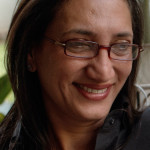 Shazia Zubari is a ceramist at Earthware Studio, Karachi
Shazia Zubari is a ceramist at Earthware Studio, Karachi 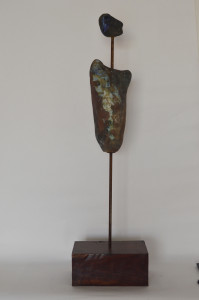
“Working in clay is one of the most exciting processes — ask anybody involved in clay, they will give you a similar response. It involves experimentation and discovery; the more you work in clay, the more you realise there is so much else to learn and discover. It’s a process with a steep learning curve. Each stage of working with clay, building, firing and glazing involves its own self-contained creativity, allowing the artist to grow and deepen his/her own understanding of this ever-so-vibrant material.
I, as an artist, am interested in the construction of sculptural work. I have in the past — and continue to — use a combination of hand-building and throwing techniques, complimented with the use of surface slips gently burnished into the ‘green’ form in order to maintain a smooth matte satin finish, reminiscent of weathering by water and air. With a focus on surface textures using traditional red clay, as they did a millennium ago in the Moenjodaro and Harappa civilisations, my latest series conceptually evokes the timeless process of erosion. Even though my earlier work was heavily scoured with texture and figurative drawings, my form maintained an organic and primitive appearance. However, more recently, my surfaces are multi-layered with coloured slips (liquid clay), along with abstract textures intentionally smooth to the touch, in an attempt to evoke a nostalgia of ‘past’; a proof of past lives, civilisations; cultures.
My work pays homage to nature and natural forces.”
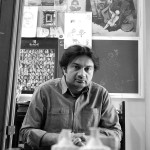 Ali Azmat is a painter and faculty member at the Department of Fine Arts, University of Punjab, Lahore.
Ali Azmat is a painter and faculty member at the Department of Fine Arts, University of Punjab, Lahore.
“‘Dangal’ is the title of my painting, in which I intended to depict the psychological realism of male domination in our society, and where I grew up — in the Akkara area of the Punjab. I deliberately selected wrestlers as models, to compose my work — they best suited my purpose. A wrestler is trained only to fight in the ring using tactics and strength to overpower the opponent in an impressive style, but he ends up adopting this behavior in his lifestyle.
In ‘Dangal 2,’ a painting done over an existing porcelain piece, I painted a pehalwan (wrestler) as a symbolic character, dressed in an embroidered black shirt, standing against an idealised backdrop. His self-centred, possessive and domineering stance is visible in his confident gaze. It reflects the way he claims ownership of his environment and his family. The decorative painting in an embellished frame is a thing of splendour and beauty, and takes the viewer into a fantasy landscape. I also painted a she-cupid with desi features in the original painting’s sky, to symbolise the native female, with a bow and arrow in hand targeting the pehalwan, with a will to eliminate him from view. The painting narrates the story of male-female dichotomy in Pakistani society.
By using already existing paintings and their ornamental frames, some of them from Pakistan, others from China, I am also commenting on how beauty can be found anywhere, not necessarily just in an art gallery.”
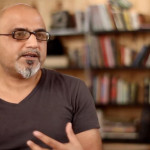 Faisal Anwar is a new media artist based in Toronto.
Faisal Anwar is a new media artist based in Toronto. 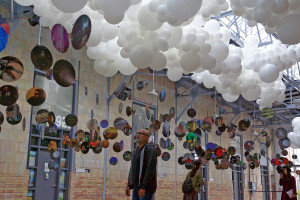
“I try to bring together art, culture and technology in odd configurations to explore social interactivity in modern urban cultures.
Like restless clouds, our memories build up in the sky of our consciousness. They remain in silence, floating in the quiet mind. It is only when we stop and look up that we realise our memories are like cloud-shaped snapshots of our lives, which are anchored by threads of our happiness and melancholia. At that moment, time that sits on the horizon of such memory clouds, reveals a past that is tied to the extraordinary present reality. Up in the Sky High takes the past photo archives of Scotiabank, Nuit Blanche as a starting point and invites the viewer to explore the infinite potential within their memory clouds, revealing its incredible beauty while sharing enriching thoughts. Large clusters of white eco-friendly balloons are suspended in the space with photo memories hanging below, creating a ‘memory lane’ allowing viewers to navigate through the still memories and the delicate sounds of movement. This work is an interactive installation created for ‘10 for 10th — Memory Lane,’ curated by Che Kothari, Scotiabank, Nuit Blanche, Toronto. This event is held every year in downtown Toronto, and is a public event that continues through the night at different venues in the city.”
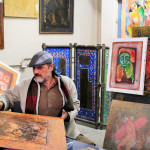 Akram Dost Baloch is a Quetta-based painter, who drawsinspiration from thesocio-political issues in the region.
Akram Dost Baloch is a Quetta-based painter, who drawsinspiration from thesocio-political issues in the region.
People try to 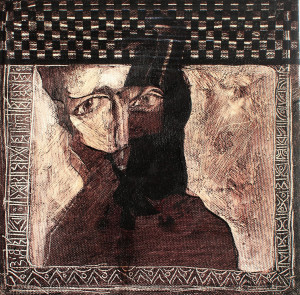 maintain a distance from full engagement with hard facts in the fear that this carries with it the possibility of great pain and moral unease. Like many, I too am not comfortable with such engagement, but I believe that out of the hesitation to confront harsh reality arises an incapacity to understand, a certain kind of emotional dyslexia. In my paintings, I have tried to highlight certain unwelcome facts and create a dialogue, which is an invitation to remedy the apathy towards, or the reluctance to deal with serious moral and social demands. Through my work, I try to penetrate the façade of the disturbing world we live in through honest interrogation. The entirety of my work as an artist has always been concerned with this kind of inner dialogue.
maintain a distance from full engagement with hard facts in the fear that this carries with it the possibility of great pain and moral unease. Like many, I too am not comfortable with such engagement, but I believe that out of the hesitation to confront harsh reality arises an incapacity to understand, a certain kind of emotional dyslexia. In my paintings, I have tried to highlight certain unwelcome facts and create a dialogue, which is an invitation to remedy the apathy towards, or the reluctance to deal with serious moral and social demands. Through my work, I try to penetrate the façade of the disturbing world we live in through honest interrogation. The entirety of my work as an artist has always been concerned with this kind of inner dialogue.
In my more recent work, I have tried to express social, political and economic anxieties prevalent in society. Of course, given the cold, harsh realities of my surroundings, the hardships and political disenfranchisement that is life in Balochistan, a somewhat wistful undertone becomes my most insistent narrative. What one thinks is made up of what one hears, sees and reads, what one feels. That is from within. What I receive from outside are tales of fear, dispossession and hatred. The grimness in my work is not an exercise in self-indulgence, but an attempt to lend such serious matters the weighty consideration they merit. The challenges of trying to express these in their required starkness motivates me to experiment and search.
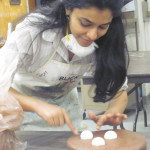 Lahore-based Rabeya Jalil
Lahore-based Rabeya Jalil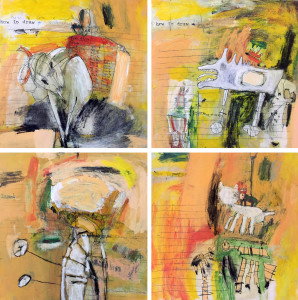
specialises in fine arts and
printmaking
The work is an interpretation of the socio-economic value systems, work ethics, morals and power structures that govern our (Pakistani) existence. I observe the individual who juggles with his/her multiple identities — coerced into the challenge of becoming a mutated self, conforming to the dogmatic and distorted demands and perceptions of the distanced other. The ‘common man’ (in us) is often reflected through animals and sometimes as inert mundane objects.
As a parallel practice (that influences these images), I work on a series of sensory drawings that stem from a personal journal of visual mapping, documenting and anecdotal logging — my informal research. Some of the mark-making in my work is derived from small research-based studies of children’s drawings and from experiences of working with young children from diverse socio-economic backgrounds.
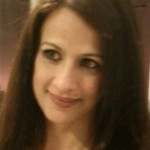 Simeen Farhat is a visual artist based in Philadelphia.
Simeen Farhat is a visual artist based in Philadelphia.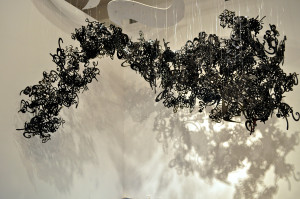
“‘Word Swarm’ is a dialogue between two people through the electronic media. I have rearranged parts of the conversation between the two from various emails so that their words make a new kind of poetic whole, expressing their differences and their interactions. What they say is serious, but I fit their words together to highlight unexpected ironies, humour and lightness. I use their words to make a visual and public theatre of their private exchanges.
My ‘Word Swarm’ is not something simply to read, it is something to experience–the words becoming dark and muddled as they move from words of meaning into shapes and forms, evocative of the shifts in our human interactions from sense to nonsense.
‘Word Swarm’ was exhibited at the Venice Biennale this year, at one of the collateral events: ‘In the Eye of the Thunderstorm.’ ‘Word Swarm’ embodied and enacted the eye inside the thunderstorm, the relationship from which these words swarm. I am showing the word-storm that lives inside all of us, especially as we try to find some sense, and some peace, with other people.
The surreal beauty and calm of Venice — the water, the architecture, the smell — became the ironic context for my storm and swarm of words.‘Word Swarm’ shows the appearance of the passion and noise of the dialogue, but it shows it all in silence — the forms of misunderstanding becoming the forms of art and space.
Sometimes, the best way to read something is to be quiet and see the shape of words, and let them speak to us.”
This article was originally published in Newsline’s Annual 2016 issue.


